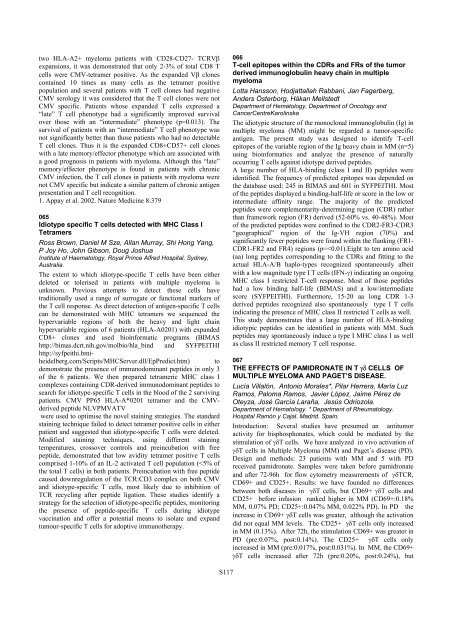Haematologica 2003 - Supplements
Haematologica 2003 - Supplements
Haematologica 2003 - Supplements
You also want an ePaper? Increase the reach of your titles
YUMPU automatically turns print PDFs into web optimized ePapers that Google loves.
two HLA-A2+ myeloma patients with CD28-CD27- TCRVβ<br />
expansions, it was demonstrated that only 2-3% of total CD8 T<br />
cells were CMV-tetramer positive. As the expanded Vβ clones<br />
contained 10 times as many cells as the tetramer positive<br />
population and several patients with T cell clones had negative<br />
CMV serology it was considered that the T cell clones were not<br />
CMV specific. Patients whose expanded T cells expressed a<br />
“late” T cell phenotype had a significantly improved survival<br />
over those with an “intermediate” phenotype (p=0.013). The<br />
survival of patients with an “intermediate” T cell phenotype was<br />
not significantly better than those patients who had no detectable<br />
T cell clones. Thus it is the expanded CD8+CD57+ cell clones<br />
with a late memory/effector phenotype which are associated with<br />
a good prognosis in patients with myeloma. Although this “late”<br />
memory/effector phenotype is found in patients with chronic<br />
CMV infection, the T cell clones in patients with myeloma were<br />
not CMV specific but indicate a similar pattern of chronic antigen<br />
presentation and T cell recognition.<br />
1. Appay et al. 2002. Nature Medicine 8:379<br />
065<br />
Idiotype specific T cells detected with MHC Class I<br />
Tetramers<br />
Ross Brown, Daniel M Sze, Allan Murray, Shi Hong Yang,<br />
P Joy Ho, John Gibson, Doug Joshua<br />
Institute of Haematology, Royal Prince Alfred Hospital, Sydney,<br />
Australia.<br />
The extent to which idiotype-specific T cells have been either<br />
deleted or tolerised in patients with multiple myeloma is<br />
unknown. Previous attempts to detect these cells have<br />
traditionally used a range of surrogate or functional markers of<br />
the T cell response. As direct detection of antigen-specific T cells<br />
can be demonstrated with MHC tetramers we sequenced the<br />
hypervariable regions of both the heavy and light chain<br />
hypervariable regions of 6 patients (HLA-A0201) with expanded<br />
CD8+ clones and used bioinformatic programs (BIMAS<br />
http://bimas.dcrt.nih.gov/molbio/hla_bind and SYFPEITHI<br />
http://syfpeithi.bmiheidelberg.com/Scripts/MHCServer.dll/EpPredict.htm)<br />
to<br />
demonstrate the presence of immunodominant peptides in only 3<br />
of the 6 patients. We then prepared tetrameric MHC class I<br />
complexes containing CDR-derived immunodominant peptides to<br />
search for idiotype-specific T cells in the blood of the 2 surviving<br />
patients. CMV PP65 HLA-A*0201 tetramer and the CMVderived<br />
peptide NLVPMVATV<br />
were used to optimise the novel staining strategies. The standard<br />
staining technique failed to detect tetramer positive cells in either<br />
patient and suggested that idiotype-specific T cells were deleted.<br />
Modified staining techniques, using different staining<br />
temperatures, crossover controls and preincubation with free<br />
peptide, demonstrated that low avidity tetramer positive T cells<br />
comprised 1-10% of an IL-2 activated T cell population (
















